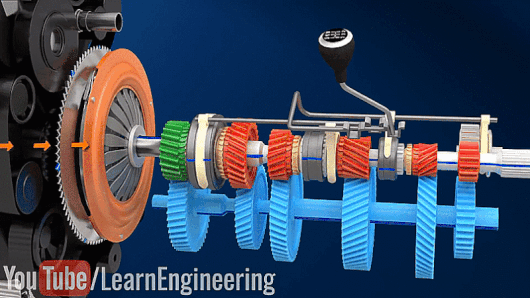
The principle of the car clutch, how the clutch works video
You can often hear the phrase “squeeze the clutch” from drivers. For many, the clutch is the leftmost pedal in a car with a manual gearbox, and drivers of cars with automatic transmission or CVT do not think about this issue at all, since there was no separate pedal in their cars for the clutch.
Let's understand what a clutch is and what function it performs.
The clutch is the link between the engine and the gearbox, it connects or disconnects the gearbox input shaft from the crankshaft flywheel. On cars with mechanics, the gears are switched only at the moment when the clutch is depressed - that is, the box is not connected to the engine and the moment of movement is not transmitted to it.

If the designers of the first cars had not thought of such a solution, then it would be simply impossible to change gears, it would be possible to change the speed of movement only with the help of the gas pedal, and to stop it would be necessary to completely turn off the engine.
At the moment there are many different types, subspecies and modifications of the clutch, but the classic clutch looks like this:
- pressure plate - clutch basket;
- driven disk - feredo;
- release bearing.
Of course, there are many other elements: the release bearing clutch, the clutch cover itself, damper springs to mitigate vibrations, friction linings that are worn on the feredo and soften the friction between the basket and the flywheel.
The clutch basket in the simplest single-disk version is in constant communication with the flywheel and constantly rotates with it. The driven disk has a splined clutch, which includes the input shaft of the gearbox, that is, all rotation is transmitted to the gearbox. If you need to change gears, then the driver presses the clutch pedal and the following happens:
- through the clutch drive system, pressure is transmitted to the clutch fork;
- the clutch fork moves the release bearing clutch with the bearing itself to the basket release springs;
- the bearing begins to put pressure on the release springs (legs or petals) of the basket;
- paws disconnect the disk from the flywheel for a while.
Then, after shifting gears, the driver releases the clutch pedal, the bearing moves away from the springs and the basket again comes into contact with the flywheel.
If you think about it, there is nothing particularly complicated in such a device, but your opinion will immediately change when you see the clutch in the analysis.
There are several types of clutch:
- single and multi-disk (multi-disk is usually used on cars with powerful engines and for automatic gearboxes);
- mechanical;
- hydraulic;
- electrical.
If we talk about the last three types, then in principle they differ from each other in the type of drive - that is, in how the clutch pedal is pressed.
The most common at the moment is the hydraulic type of clutch.
Its main elements are the master and slave cylinders of the clutch. Pressing the pedal is transmitted to the master cylinder by means of a rod, the rod moves a small piston, respectively, the pressure inside the cylinder increases, which is transmitted to the working cylinder. The working cylinder also has a piston connected to the rod, they are set in motion and put pressure on the release bearing fork.

In a mechanical type of clutch, the clutch pedal is connected through a cable to a fork that drives the bearing.
The electric type is the same mechanical, with the difference that the cable, after pressing the pedal, is set in motion with the help of an electric motor.
Clutch in cars with automatic transmission
Although such cars do not have a clutch pedal, this does not mean that there is nothing between the engine and the gearbox either. Usually in cars with automatic transmission, more advanced multi-plate wet clutch options are used.
It is wet because all its elements are in an oil bath.
The clutch is pressed using servo drives or actuators. Here the electronics play a big role, which determines which gear to shift, and while the electronics are thinking about this issue, there are small failures in the work. The automatic transmission is convenient in that you do not need to constantly squeeze the clutch, the automation does everything by itself, but the truth is that repairs are quite expensive.
And here is a video about the principle of operation of the clutch, as well as the gearbox.
Loading…
